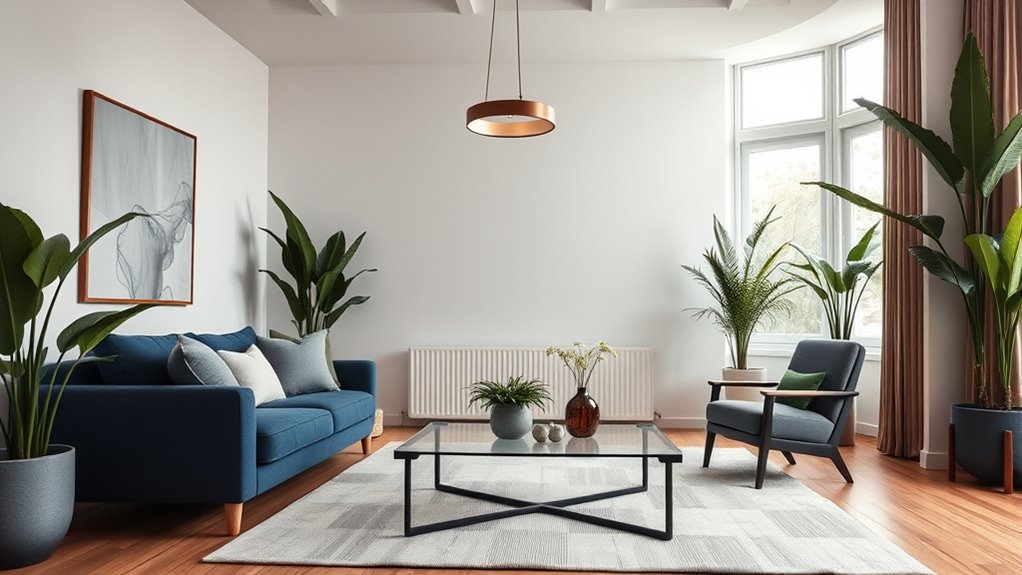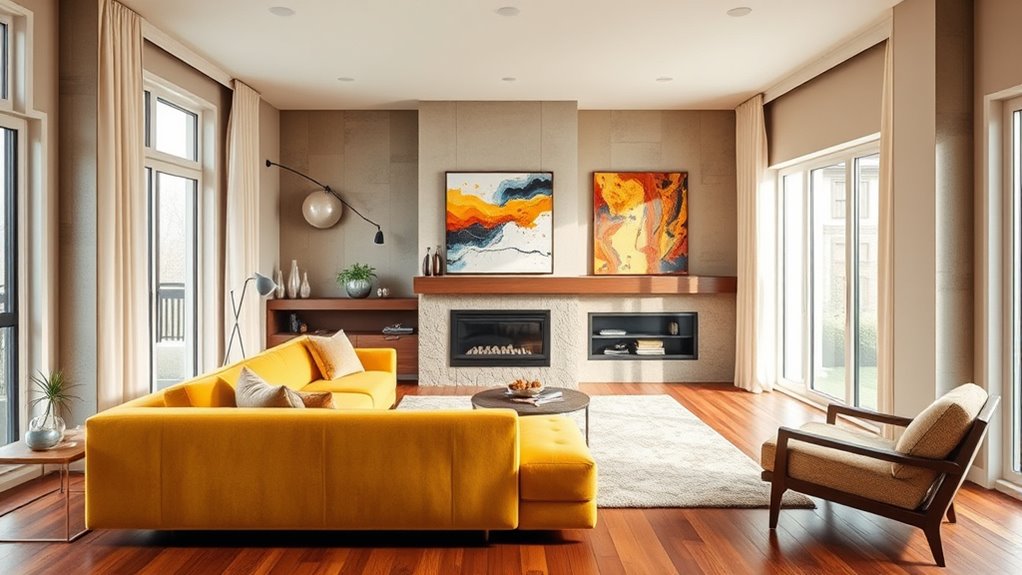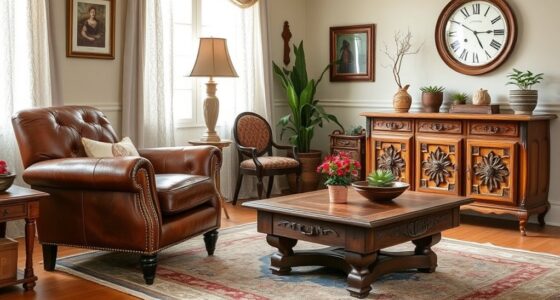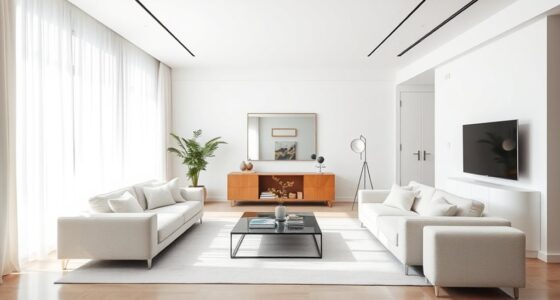The rule of thirds helps you create a balanced, engaging room by positioning key elements along imaginary lines and intersections. Instead of centering furniture or decor, you place sofas, artwork, and lighting to guide the eye naturally across the space. This technique adds visual interest and harmony, making your room feel thoughtfully curated. Keep exploring, and you’ll discover how to apply this principle to turn your space into a balanced, inviting environment.
Key Takeaways
- The rule divides the room into a 3×3 grid, guiding placement of furniture and decor for visual balance.
- Key elements like sofas and artwork are positioned along lines or at intersections for natural flow.
- Off-center placement of focal points enhances visual interest and prevents a static, symmetrical look.
- Distributing colors, patterns, and accessories along grid lines creates cohesion and dynamic visual appeal.
- Overall, it helps designers craft rooms with harmonious, engaging layouts that feel curated and inviting.

When designing a room, applying the rule of thirds can help create a balanced and visually appealing space. This principle, borrowed from photography and art, divides a room into nine equal parts using two horizontal and two vertical lines. By aligning key elements along these lines or at their intersections, you guide the eye naturally across the space, making it feel harmonious and well-composed. Instead of placing your sofa smack in the center, for example, position it so that it’s aligned with one of the vertical lines. This subtle shift creates a more dynamic, inviting layout that feels thoughtfully arranged rather than static.
You can also use the rule of thirds to determine the placement of artwork, mirrors, or lighting. Hang a large piece of art so that its focal point aligns with an intersection point. This draws attention without overwhelming the room, creating a visual anchor that balances out the other elements. When placing lamps or light fixtures, consider positioning them along these lines or at their intersections to enhance the flow of light and focus. This technique helps avoid cluttered or uneven spaces, giving each element a purpose within the overall composition.
Using the rule of thirds also guides your choice of focal points. If you want a fireplace or entertainment center to stand out, position it off-center but aligned with a vertical line. This creates a more engaging visual experience, encouraging the eye to explore the room rather than fixate on a symmetrical, potentially dull, center. It’s especially useful in open-concept spaces where multiple zones compete for attention. Applying this rule ensures each area feels intentional and balanced, preventing any one part from dominating the entire room.
In terms of color and pattern, the rule of thirds can help you distribute visual weight evenly. For instance, if you paint a wall a bold color, consider placing artwork or decorative pieces along the lines rather than centering them. This technique distributes visual interest across the space, making it feel cohesive and lively. When arranging furniture, think about the placement of chairs and tables relative to these lines, ensuring there’s enough negative space to breathe and that the visual weight feels evenly spread out.
Additionally, understanding the importance of visual balance can enhance your ability to craft a harmonious room by applying the rule of thirds thoughtfully. Ultimately, using the rule of thirds in room design isn’t about strict rules but about creating a flow that feels natural and pleasing. It’s a tool to help you think critically about placement and balance, making your space feel thoughtfully curated rather than haphazard. By consciously applying this principle, you’ll craft a room that captures attention, feels inviting, and exudes a sense of harmony that’s appealing to everyone who enters.
Frequently Asked Questions
How Do I Adapt the Rule for Small or Oddly Shaped Rooms?
To adapt the rule for small or oddly shaped rooms, you should focus on balance rather than strict grid placement. Divide your space mentally into thirds, then place key furniture or focal points along these lines or at intersections. Keep proportions in mind, avoiding overcrowding. Use scaled-down furniture and strategic accessories to create visual harmony, making the room feel more cohesive and inviting without overwhelming the space.
Can the Rule of Thirds Be Applied to Outdoor Spaces?
Yes, you can definitely apply the rule of thirds to outdoor spaces. Divide your yard or garden into three sections, whether through pathways, plant beds, or seating areas. Position focal points like a fountain, tree, or seating area along these lines or at intersections. This creates visual balance and harmony, making your outdoor space feel more intentional and inviting. Experiment with different elements to find what best suits your style.
What Are Common Mistakes When Using the Rule in Room Design?
You often make the mistake of overcomplicating the layout or trying to fit too many focal points, which can create visual clutter. Avoid placing key furniture or decor too symmetrically or too close to the edges, as it disrupts balance. Also, don’t ignore scale and proportion—sizes should complement each other. Remember, the goal is harmony, so keep the design simple, balanced, and thoughtfully arranged.
How Flexible Is the Rule for Personal Style Preferences?
You can definitely be flexible with the rule of thirds to suit your personal style. While it’s a helpful guideline for balanced compositions, don’t feel restricted—alter it to reflect your taste. Feel free to experiment by shifting focal points, mixing styles, or breaking the rules altogether. Your space should reflect your personality, so adapt the rule as needed to create a look that feels authentic and comfortable for you.
Are There Tools or Apps to Help Visualize the Rule of Thirds?
Yes, there are plenty of tools and apps to help you visualize the rule of thirds. You can use design apps like Canva or Adobe Spark that include grid overlays, making it easy to plan your room layout. Smartphone camera apps also often have grid features, helping you align furniture and decor. These tools make it simple to apply the rule, ensuring your space feels balanced and visually appealing.
Conclusion
By applying the rule of thirds, you create balanced, visually appealing rooms that feel effortlessly styled. Some might think it’s too rigid or formulaic, but when used thoughtfully, it enhances your space without stifling creativity. Remember, it’s a guideline, not a strict rule—so feel free to break it when your unique style calls for it. Ultimately, mastering this principle helps you craft rooms that are both harmonious and personalized, elevating your design game effortlessly.









